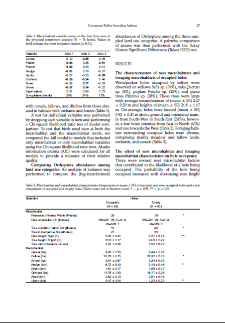- Search in all Repository
- Literature and maps
- Archeology
- Mills database
- Natural sciences
Advanced search
Advanced search
Advanced search
Advanced search
Advanced search

Object
Title: Individual and sexual differences in the calls of the monomorphic white-faced whistling duck Dendrocygna viduata
Creator:
Volodin, Il'â Aleksandrovič (1962– ) ; Polska Akademia Nauk. Muzeum i Instytut Zoologii.
Date issued/created:
Resource type:
Subtitle:
Acta Ornithologica, vol. 40, no. 1 ; Osobnicze i międzypłciowe zróżnicowanie głosów u monomorficznej drzewicy białolicej ; Call differences in the white-faced whistling duck
Contributor:
Museum and Institute of Zoology, Polish Academy of Sciences
Publisher:
Place of publishing:
Description:
Bibliogr. p. 50-51 ; P. [43]-52 : ill. ; 27 cm ; Abstract. pol.
Type of object:
Abstract:
The White-faced Whistling Duck is a waterfowl species lacking any differences in ornamentation, coloration, size or behavior between the sexes. For distant communication, this species uses loud whistles. We analyzed 12 spectral parameters of 344 whistles from 23 captive adult ducks (14 males and 9 females). Discriminant analysis showed 94% correct assignment to an individual (N = 279 calls from 14 birds; 15–22 calls per bird). Separately for 8 males (162 calls) and for 6 females (117 calls), discriminant analysis showed 99% and 93% correct assignment to individuals respectively. Discriminant analysis for sex (N = 86; 3 calls from each of 14 males and 5 calls from each of 9 females) showed 100% correct assignment. Intersexual differences were governed by frequency parameters, the values of which were significantly higher in females than in males. Cluster analysis showed that differences between sexes were expressed significantly more strongly than the individual differences. The fact that the “acoustical keys” differed as regards the identification of individual birds or their sex may significantly enhance the reliability of acoustical recognition systems in the White-faced Whistling Duck. The data are discussed in the context of the biology of the White-faced Whistling Duck and significant intersexual differences in syringial and tracheal anatomy, which may be responsible for the sharp distinctions between the sexes in the calls of this species.
Relation:
Volume:
Issue:
Start page:
End page:
Detailed Resource Type:
Format:
Resource Identifier:
Source:
MiIZ PAN, call no. patrz sygn. czas. P.257, Vol. 40, No 1 ; MiIZ PAN, call no. patrz sygn. czas. P.4568, Vol. 40, No 1 ; click here to follow the link
Language:
Language of abstract:
Rights:
Terms of use:
Copyright-protected material. May be used within the limits of statutory user freedoms
Digitizing institution:
Museum and Institute of Zoology of the Polish Academy of Sciences
Original in:
Library of the Museum and Institute of Zoology of the Polish Academy of Sciences
Access:
Object collections:
- Digital Repository of Scientific Institutes > Partners' collections > Museum and Institute of Zoology PAS > Scientific Journals
- Digital Repository of Scientific Institutes > Partners' collections > Museum and Institute of Zoology PAS > MIZ PAN Publications > Acta Ornithologica
- Digital Repository of Scientific Institutes > Literature > Journals/Articles
Last modified:
Oct 2, 2020
In our library since:
Jul 28, 2015
Number of object content downloads / hits:
39
All available object's versions:
https://rcin.org.pl./publication/74870
Show description in RDF format:
Show description in RDFa format:
Show description in OAI-PMH format:
Objects Similar
Polak, Marcin Polska Akademia Nauk. Muzeum i Instytut Zoologii
Liu, Rusun Yu, Quing Lei, Fumin
Matysek-Imielińska, Magdalena
Serkowska, Hanna
Schmidt, Veronika (1973– ) Schaefer, Heinrich Martin Leisler, Bernd
Woon-Kee, Paek Hahm, Kyu-Hwang

 INSTYTUT ARCHEOLOGII I ETNOLOGII POLSKIEJ AKADEMII NAUK
INSTYTUT ARCHEOLOGII I ETNOLOGII POLSKIEJ AKADEMII NAUK
 INSTYTUT BADAŃ LITERACKICH POLSKIEJ AKADEMII NAUK
INSTYTUT BADAŃ LITERACKICH POLSKIEJ AKADEMII NAUK
 INSTYTUT BADAWCZY LEŚNICTWA
INSTYTUT BADAWCZY LEŚNICTWA
 INSTYTUT BIOLOGII DOŚWIADCZALNEJ IM. MARCELEGO NENCKIEGO POLSKIEJ AKADEMII NAUK
INSTYTUT BIOLOGII DOŚWIADCZALNEJ IM. MARCELEGO NENCKIEGO POLSKIEJ AKADEMII NAUK
 INSTYTUT BIOLOGII SSAKÓW POLSKIEJ AKADEMII NAUK
INSTYTUT BIOLOGII SSAKÓW POLSKIEJ AKADEMII NAUK
 INSTYTUT CHEMII FIZYCZNEJ PAN
INSTYTUT CHEMII FIZYCZNEJ PAN
 INSTYTUT CHEMII ORGANICZNEJ PAN
INSTYTUT CHEMII ORGANICZNEJ PAN
 INSTYTUT FILOZOFII I SOCJOLOGII PAN
INSTYTUT FILOZOFII I SOCJOLOGII PAN
 INSTYTUT GEOGRAFII I PRZESTRZENNEGO ZAGOSPODAROWANIA PAN
INSTYTUT GEOGRAFII I PRZESTRZENNEGO ZAGOSPODAROWANIA PAN
 INSTYTUT HISTORII im. TADEUSZA MANTEUFFLA POLSKIEJ AKADEMII NAUK
INSTYTUT HISTORII im. TADEUSZA MANTEUFFLA POLSKIEJ AKADEMII NAUK
 INSTYTUT JĘZYKA POLSKIEGO POLSKIEJ AKADEMII NAUK
INSTYTUT JĘZYKA POLSKIEGO POLSKIEJ AKADEMII NAUK
 INSTYTUT MATEMATYCZNY PAN
INSTYTUT MATEMATYCZNY PAN
 INSTYTUT MEDYCYNY DOŚWIADCZALNEJ I KLINICZNEJ IM.MIROSŁAWA MOSSAKOWSKIEGO POLSKIEJ AKADEMII NAUK
INSTYTUT MEDYCYNY DOŚWIADCZALNEJ I KLINICZNEJ IM.MIROSŁAWA MOSSAKOWSKIEGO POLSKIEJ AKADEMII NAUK
 INSTYTUT PODSTAWOWYCH PROBLEMÓW TECHNIKI PAN
INSTYTUT PODSTAWOWYCH PROBLEMÓW TECHNIKI PAN
 INSTYTUT SLAWISTYKI PAN
INSTYTUT SLAWISTYKI PAN
 SIEĆ BADAWCZA ŁUKASIEWICZ - INSTYTUT TECHNOLOGII MATERIAŁÓW ELEKTRONICZNYCH
SIEĆ BADAWCZA ŁUKASIEWICZ - INSTYTUT TECHNOLOGII MATERIAŁÓW ELEKTRONICZNYCH
 MUZEUM I INSTYTUT ZOOLOGII POLSKIEJ AKADEMII NAUK
MUZEUM I INSTYTUT ZOOLOGII POLSKIEJ AKADEMII NAUK
 INSTYTUT BADAŃ SYSTEMOWYCH PAN
INSTYTUT BADAŃ SYSTEMOWYCH PAN
 INSTYTUT BOTANIKI IM. WŁADYSŁAWA SZAFERA POLSKIEJ AKADEMII NAUK
INSTYTUT BOTANIKI IM. WŁADYSŁAWA SZAFERA POLSKIEJ AKADEMII NAUK


































